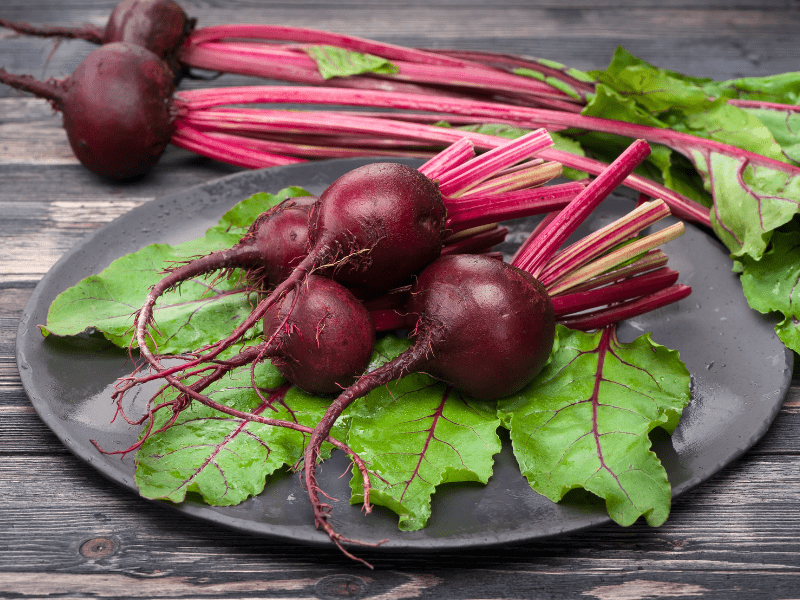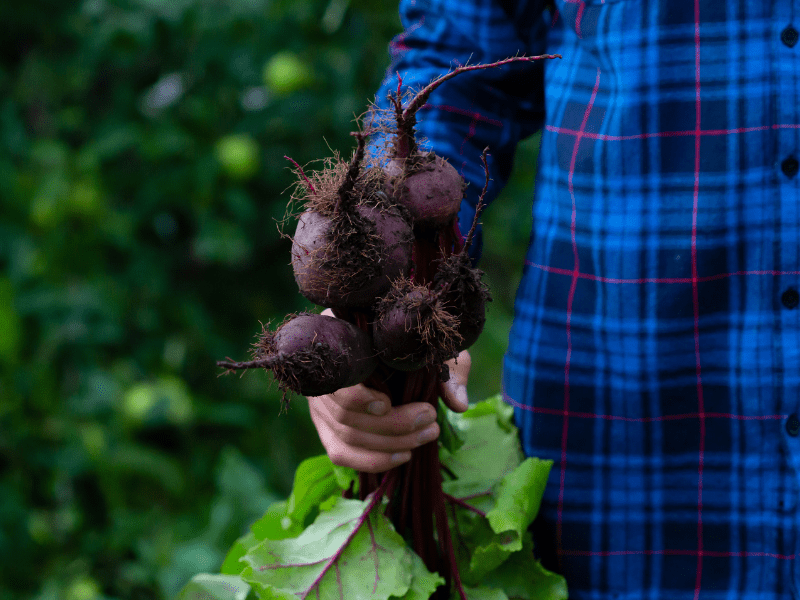Beetroot is less popular than other veggies, but this sweet bulbous plant is easy to grow and care for. I find this ruby-coloured vegetable endlessly versatile.
Beetroot is tasty, roasted, pickled, or used as a base for delicious Mediterranean soup recipes. Easy to grate and slice – perfect for adding depth and colour to Summer salads.
Taste Buds teased? Let’s learn more about growing and caring for the delicious beetroot.
Can’t Wait To Start Growing Beetroot? Save Time With These Jump Links:-
- Interesting Beetroot Facts
- How To Grow Beetroot
- How To Care For Beetroot
- Beetroot Diseases And Pests
- Beetroot Top Tips

| Common name: Beetroot |
| Latin name: Beta vulgaris |
| Family: Amaranthaceae |
| Growth: Annual/Biennial |
| Season: late spring/summer |
| Height: up to 30cm |
| Soil: well-drained but moist, neutral to slightly alkaline, 7.0 to 7.5 |
Interesting Beetroot Facts
Beetroot Is A Superfood
- Beetroots are one of the most nutrient-rich vegetables, providing a good source of antioxidants, riboflavin, iron, manganese and vitamins A, C and K. They are a root vegetable native to the warm climate of the Mediterranean.
- When we eat beetroot, we actually eat the plant’s root, which grows beneath the soil.
- Beetroot plants also grow sweet broad leaves above ground which we can also pick for use in salads and soup, similar to spinach.
MONEY SAVING TIP
You can even use beetroot leaves, fresh in salads or wilted in soup.
- Beetroots typically have a rounded structure, but some less common varieties produced elongated roots, similar in shape to parsnips.
How To Grow Beetroot
Growing Beetroot from Seeds
The sowing season for beetroot is late spring – April to June.
To grow beetroot outdoors in your garden or raised bed;
or raised bed;
- you simply need to prepare short rows (drills) 25 -30cm apart.
- Place the seeds spaced 10cm apart within each row.
- Water the rows of sown beetroot seeds regularly and de-weed as required. This helps to prevent nutrient competition.
CHEFS TIP
Choose a spot with full sun, as this will produce the best quality beetroot and leaves.
Beetroot grows well in large containers. Adding a multi-purpose compost will produce good results during the sowing process.
Beetroot Care
How To Water Beetroot.
Regular watering will prevent the beetroot bulbs from becoming woody.
Don’t forget:
Keep the soil around your beetroot plants relatively light and weed-free.
When Can I Harvest Beetroot?
Beetroot is best harvested when the root is the same size as a cricket ball.
From sowing to harvest, this takes approximately 10 weeks. If you are growing elongated varieties, growth time may be up to 20 weeks.
How To Harvest Beetroot
To harvest your beetroot:
- Take a firm hold where the leaf stems meet the root and pull upward.
- Trim the leaves from the root, leaving roughly 5cm of stalk attached to the root.
- The roots should be washed to remove dirt and insects.

Beetroot Diseases and Pests
Slugs and Snails
The most common pests for beetroot growers to be wary of are slugs and snails. They are partial to a beetroot seedling and can easily ruin a good sowing season.
for beetroot growers to be wary of are slugs and snails. They are partial to a beetroot seedling and can easily ruin a good sowing season.
To keep slugs and snails away from your beetroot, try growing them under fine netting. Alternatively, you can encourage natural predators in your garden, such as hedgehogs and frogs. Adding crushed eggshells to the soil around your plants may also help to keep slugs and snails away.
Leaf Spot
There are several types of Leaf Spot that beetroot are susceptible to, depending on your region. Leaf spot is caused by bacterial or fungal spores, causing small brown spots to appear on the leaves.
This reduces the plant’s ability to photosynthesise, which means the plant cannot absorb enough nutrients from the soil. This often results in stunted growth of the leaves and smaller root growth.
The best way to prevent leaf rot is to water directly onto the soil, not on the leaves, as this can spread spores further. You may need to use a biological fungicide for more severe leaf spot issues. This usually comes in spray form.
Beet Curly Top
Beet curly top is a viral disease common among beetroot and other plants in the same family. The virus causes the edges of the leaves to curl inward. Infected plants produce smaller, discoloured leaves and stiff veins. The root of the plant may also be stunted or even deformed.
The leafhopper insect spreads the virus, so controlling the bugs will help prevent the spread of disease among your plants. Leafhoppers are small green or yellow insects that feed on the foliage of beetroot and tomato.
Some cultivars of beetroot are resistant to the virus that causes curly top. Still, they are only readily available in some countries.
The best way to prevent leafhoppers from getting onto your plants is to grow them under fine netting or floating row covers made from translucent plastic.

Beetroot Tips
So, there you have it; growing beetroot at home is a breeze if you follow a few simple tips. Here’s a recap:
- Sow beetroot seeds in full sun to ensure the best quality crop.
- Water directly onto the soil to reduce the risk of spreading bacterial and fungal spores.
- Weed regularly to prevent nutrient competition and bug infestations.
- Grow beetroot under floating row covers to keep out bugs and birds.
Recent Posts
Rocket is a fresh leafy vegetable with a peppery, slightly spicy tang. It's a staple ingredient in my salads and great for dressing pizza, tarts, and soups. Rocket is one of the easiest veggies to...
Suppose you are looking for an easy-to-grow, highly productive vegetable for your home garden. In that case, courgettes are the way to go. Not only do they have a short growing season, but they are...
